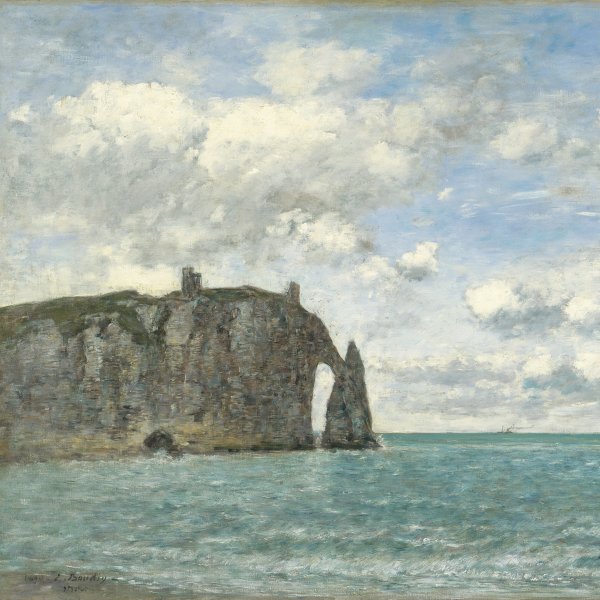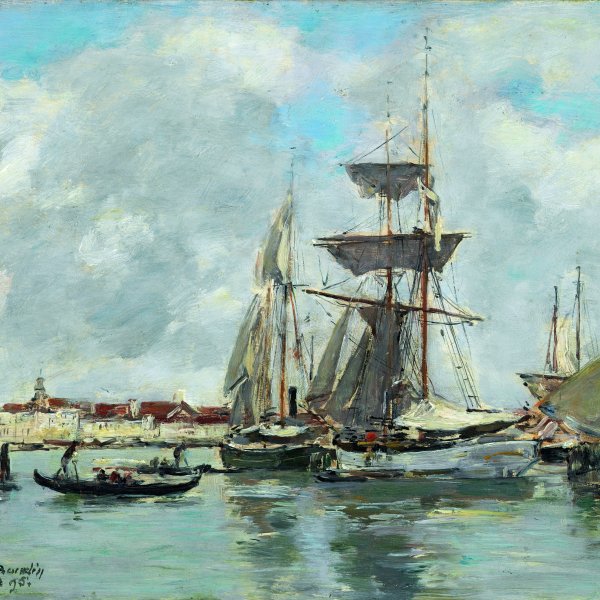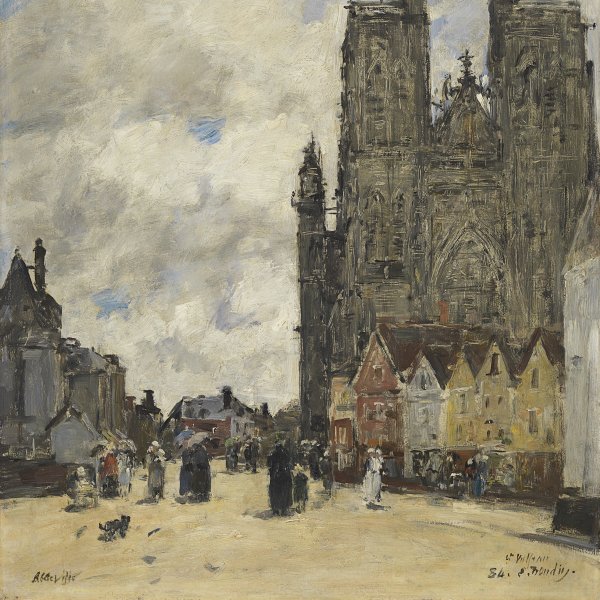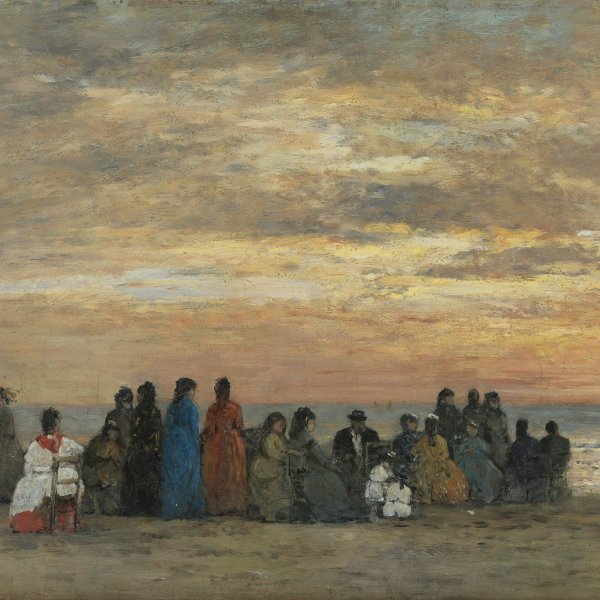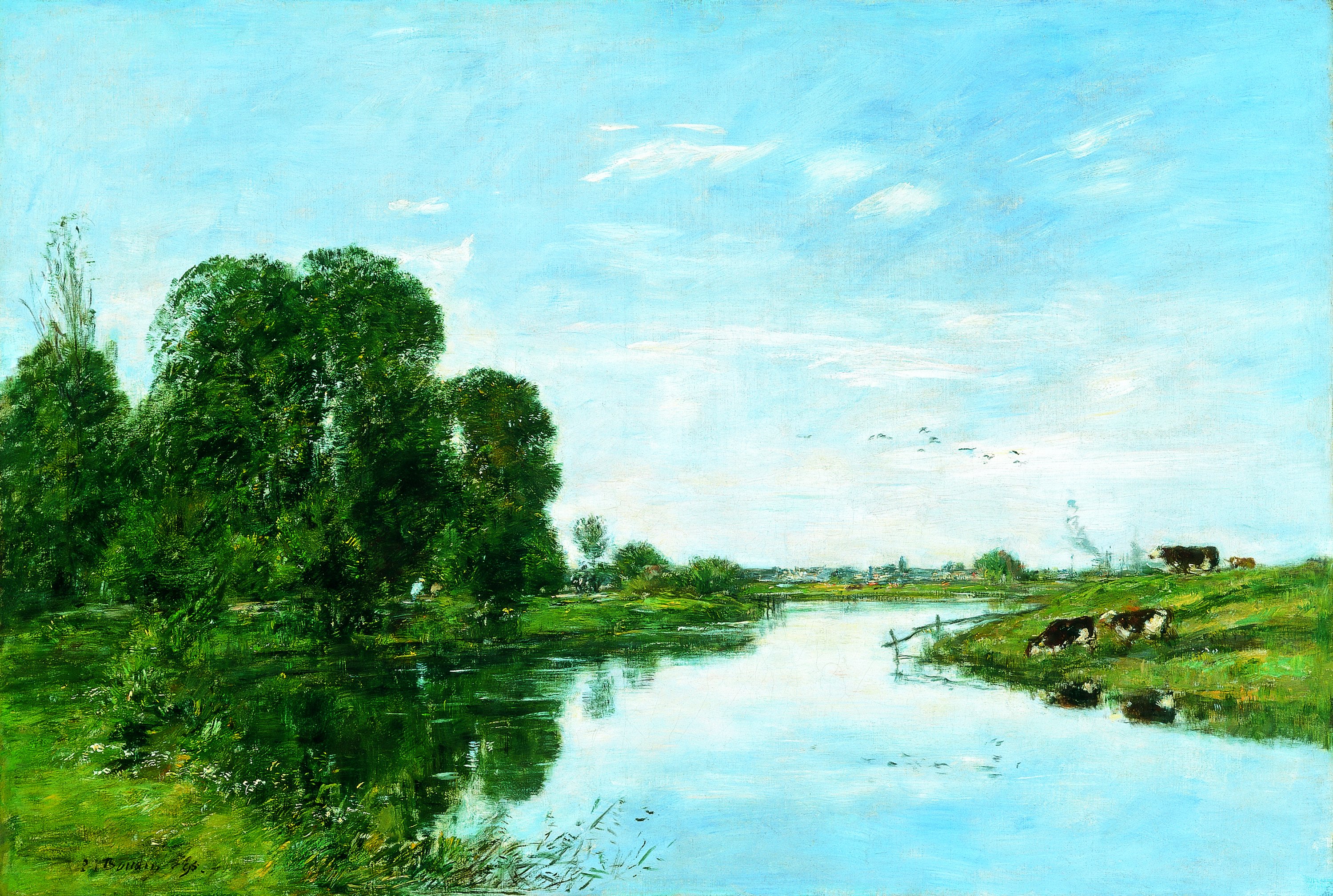The River Touques at Saint-Arnoult
1895
Oil on canvas.
51 x 75 cm
Carmen Thyssen Collection
Inv. no. (
CTB.1998.38
)
Not exhibited
Level 2
Permanent Collection
Level 1
Permanent Collection
Level 0
Carmen Thyssen Collection and Temporary exhibition rooms
Level -1
Temporary exhibition rooms, Conference room and EducaThyssen workshop
On 1 March 1895, in a letter to his friend the painter Braquaval, Eugène Boudin admitted: "I find my work increasingly more straining, in particular since I have been trying to finish my studies outside". Boudin's temperament is condensed in these few words: tenacity, humility, doubt, but at the same time certainty in the pursuit of his work. At his age, other painters would have certainly paid more attention to their aches and pains. Boudin only had three years left to live and he already suffered from the stomach cancer that would kill him. In spite of this, he still painted out of doors, summer and winter alike. A Norman born and bred, Boudin painted many of his works in his native region, the Pays d'Auge. In 1885 he had a villa built in Deauville and that residence enabled him to spend longer and more frequent periods on the coast or inland.
There are several views of the river Touques among his works. They are the "rural" counterpart of the seascapes and beach views of summer resorts. They are the reflection of a love never denied for the countryside, the river banks and the herds in the fields. As a young painter, in the years around 1855-1860, he had followed Constant Troyon, who worked with paints and pastels on the rural landscapes of the valley of the Touques.
This river rises in the department of Orne and winds for 108 km through fields, towns and villages: Fervaques, Lisieux, Pont-l'Evêque... giving to that region rich pastures for cattle and horses. Close to its mouth, situated between Trouville and Deauville, it flows lazily, sometimes becoming marshes liable to flooding which water the villages of Saint-Arnoult and Touques, the localities along the river course most often represented (with the exception of the views of the river flowing into the sea in Trouville, between the two piers).
Boudin executed several times the view depicted here: once in 1891, three times in 1893 and twice in 1895. To these we have to add others, very close to Saint-Arnoult: the "oxbows in Deauville, " the Touques with low or high tide, the banks of the river Touques in Trouville during the spring tides. All these works are rural views of the river flowing between its verges and in all weather.
The Touques in Saint Arnoult appears therefore precisely in five paintings of the same size and a smaller one (36 x 58 cm). The viewpoint chosen by the artist and the composition are exactly the same: the bend of the river is limited by a grassy verge on the right and one planted with tall trees on the left. The skies differ in each of these paintings: they are blue, cloudy or menacing. This landscape, dominated by cold colours (green and blue), is enlivened by small motifs (fishermen, strollers, cattle in the meadows) which are depicted with brighter colours: yellow, blue, white, vermilion or brown for the coats of the cattle, and those living patches humanise the scene which would otherwise seem fixed. The movement and direction of the wind are conveyed by the smoke and the flight of the birds. This is how Boudin always works. With small brushstrokes, he allows us to uncover his subject gradually. The eyes of the beholder wander around the scene and stop on a detail, in order to appreciate all its serene and discreet beauty. It is not the originality of the subject or the bright colours which enable us to appreciate it, but the harmony of shades, the tenderness of the greens, the delicacy of the reflections, the swiftness of the brushstroke on the canvas, and the subtle art of suggestion of which Boudin was a master.
Monet was known for his "series, " but Boudin, in his own way, had already applied this technique by multiplying the views of a same place and by varying the lighting in each of them.
In 1895 Boudin registered in his account books 3650 FF for the sale of paintings. There were many dealers, among which Allard and Noël, who bought 14 paintings for a price between 300 and 400 FF each (format 6 and 8) and for 600 and 700 FF for a format 20. In January 1895, these dealers bought from Boudin for 700 FF a painting entitled The Touques river in Saint-Arnoult of a format 20, which is roughly the format of this painting. If it was bought in January 95 and dated at that time, then this painting was probably made the previous spring or summer. Boudin, like Monet, sometimes dated his recently painted works at the time when they were sold.
Anne-Marie Bergeret-Gourbin
There are several views of the river Touques among his works. They are the "rural" counterpart of the seascapes and beach views of summer resorts. They are the reflection of a love never denied for the countryside, the river banks and the herds in the fields. As a young painter, in the years around 1855-1860, he had followed Constant Troyon, who worked with paints and pastels on the rural landscapes of the valley of the Touques.
This river rises in the department of Orne and winds for 108 km through fields, towns and villages: Fervaques, Lisieux, Pont-l'Evêque... giving to that region rich pastures for cattle and horses. Close to its mouth, situated between Trouville and Deauville, it flows lazily, sometimes becoming marshes liable to flooding which water the villages of Saint-Arnoult and Touques, the localities along the river course most often represented (with the exception of the views of the river flowing into the sea in Trouville, between the two piers).
Boudin executed several times the view depicted here: once in 1891, three times in 1893 and twice in 1895. To these we have to add others, very close to Saint-Arnoult: the "oxbows in Deauville, " the Touques with low or high tide, the banks of the river Touques in Trouville during the spring tides. All these works are rural views of the river flowing between its verges and in all weather.
The Touques in Saint Arnoult appears therefore precisely in five paintings of the same size and a smaller one (36 x 58 cm). The viewpoint chosen by the artist and the composition are exactly the same: the bend of the river is limited by a grassy verge on the right and one planted with tall trees on the left. The skies differ in each of these paintings: they are blue, cloudy or menacing. This landscape, dominated by cold colours (green and blue), is enlivened by small motifs (fishermen, strollers, cattle in the meadows) which are depicted with brighter colours: yellow, blue, white, vermilion or brown for the coats of the cattle, and those living patches humanise the scene which would otherwise seem fixed. The movement and direction of the wind are conveyed by the smoke and the flight of the birds. This is how Boudin always works. With small brushstrokes, he allows us to uncover his subject gradually. The eyes of the beholder wander around the scene and stop on a detail, in order to appreciate all its serene and discreet beauty. It is not the originality of the subject or the bright colours which enable us to appreciate it, but the harmony of shades, the tenderness of the greens, the delicacy of the reflections, the swiftness of the brushstroke on the canvas, and the subtle art of suggestion of which Boudin was a master.
Monet was known for his "series, " but Boudin, in his own way, had already applied this technique by multiplying the views of a same place and by varying the lighting in each of them.
In 1895 Boudin registered in his account books 3650 FF for the sale of paintings. There were many dealers, among which Allard and Noël, who bought 14 paintings for a price between 300 and 400 FF each (format 6 and 8) and for 600 and 700 FF for a format 20. In January 1895, these dealers bought from Boudin for 700 FF a painting entitled The Touques river in Saint-Arnoult of a format 20, which is roughly the format of this painting. If it was bought in January 95 and dated at that time, then this painting was probably made the previous spring or summer. Boudin, like Monet, sometimes dated his recently painted works at the time when they were sold.
Anne-Marie Bergeret-Gourbin





